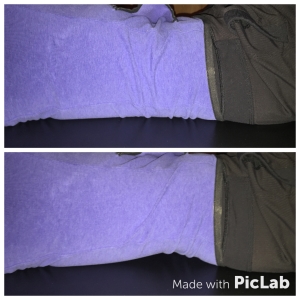I often get asked about the pelvic floor muscles. It’s not an area that everyone is comfortable talking about, but it is quite important to our health and wellness.
We all—men and women—have pelvic floor muscles. I’ve found that not all men know they have pelvic floor muscles unless they wind up with a prostate issue and they learn about them. Men should be aware of these muscles because improper tone of the pelvic floor can be linked to low back pain while proper tone can help provide sustained erections. These muscles matter.
Most women are familiar with their pelvic floor. It is very common for women to urinate a little when they sneeze, cough, or do a jumping jack because the pelvic floor isn’t firing properly, especially after having children. Again, while this is a common occurrence, it is a sign that the pelvic floor muscles are not engaging properly. Also, when women experience pelvic prolapse (something men can experience too, but less often), parts that belong inside can find their way outside. The proper tone of the pelvic floor muscles helps resist this process. These muscles can be connected to back pain in women too.
Since the pelvic floor muscles matter so much and can impact our lives on a daily basis, how can we find and engage them? Here are a few tips for working with your pelvic floor.
The Kegel
Kegel exercises, named after Dr. Kegel who first introduced the concept, involve activating the muscles of the pelvic floor. If you are not sure whether you can do this on command, the next time you are urinating stop mid-stream. The muscles you use to stop are your Kegels. Once you’ve found them, it’s best not to use urinating as a way to exercise the Kegels…so normally let everything flow freely once you release those muscles.
When you stop midstream, you are engaging part of the pelvic floor. But it is important to connect with the entirety of all three muscles from the front to the back. Notice what you feel when you engage (it’s subtle so it can be challenging to pick up on what you feel…that’s okay…you’re completely normal…keep trying.) What you should feel are muscles engaging gently at the base of your pelvis from pubic bone to tail bone.
Full Pelvic Floor Engagement
Think for a moment (or feel if you are comfortable) about where your public bone is. Standing, it’s more in front of our body than below. A fully engaged Kegel will provide sensation to the lower front of your body. In addition, when you engage your Kegels your deepest ab muscle should subtlety automatically engage too. Can you feel that low in your abdomen between your navel and public bone? Are you able to feel your pelvic floor all the way forward to your pubic bone?
If you want to ensure you are finding the pelvic floor muscles in back, next time you take a shower, find your table bone with your finger. When you engage and release your Kegels you should be able to feel the tail bone wiggle slightly.
Engaging & Releasing the Pelvic Floor
When we think of a Kegel we often think of tightening the muscle. But the ability to tighten and release are both important. As long as you are fully engaging the muscle from front to back there is no wrong or right way to do a Kegel. You can engage and hold for a few seconds or a few deep breaths and then release fully. You can slowly engage for a count of five and then release for a count of five. Variety in timing is beneficial. But make sure you focus on both engaging and releasing.
Gentle
When you start doing pelvic floor exercises…be gentle with yourself and your kegels. These are small muscles that respond to subtle movement versus brute force. They can’t do big movements. Plus, if you haven’t been working them or you have had children, it may take time to find them and feel like you are actually engaging the whole muscle. Let it be a process.
Be gentle with yourself.
Neutral
If you are struggling to feel the muscles and not sure you are doing them at all, make sure your pelvis is in a neutral position. It will be easier to engage and therefore easier to feel in that position. The video below will help explain a neutral pelvis.
Pelvic Floor Exercises
In addition to a basic Kegel exercise, consider trying these to help you find and feel those muscles activate.
Press Toes
Standing with legs hip distance apart, toes pointing forward, barefoot ideally, and pelvis neutral simply press your toes down into the floor. When you do this, do you feel your pelvic floor engage? This is a good starting point if you have been struggling with the basic Kegel exercise.
Cat Stretch
Set up: Get on all fours with knees hip distance apart and hands shoulder width apart. Normally in a cat stretch (see the first part of the video below), we focus on rounding the spine and unwinding, sticking the tailbone out and lifting the head. We are still going to do that. But while the spine moves in each direction at the end of each range we are going to take note of the pelvic floor muscles. If thinking of bones instead of muscles is more helpful in your mind, think of what your sitz bones (the boney protrusions at the bottom of your butt).
When you round the spine, take a moment to feel the sitz bone gently squeezing together (the pelvic floor gets shorter). When you unwind take a moment at the end to visualize your sitz bones spreading apart (the pelvic floor fully lengthening). These are not big movements.
I hope this gives you a place to start. I know this is not a comfortable topic for everyone so I appreciate you reading and I hope you find the information useful. The goal is to make you feel better in your body and provide tools to reduce pain and discomfort…and to help keep all our parts inside for years to come.
Keep Reading
Here is a more detailed post about wiggling your tail bone.
Another variation of the cat stretch exercise for finding your pelvic floor.
More information to help you find neutral.
Keep Connected
Order Your Copy of Keep Moving Today!
Subscribe to the Keep Moving Blog
Like the Personal Euphoria Facebook page
Find us on Twitter
Follow me on Instagram
Subscribe to my YouTube Channel

